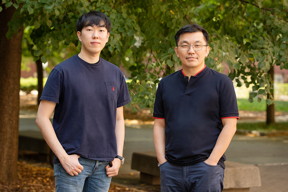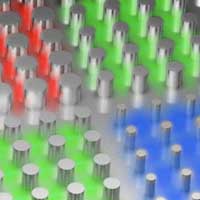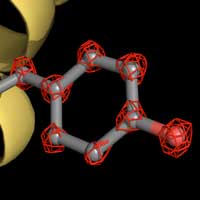Home > Press > Octopus-inspired sucker transfers thin, delicate tissue grafts and biosensorsPostdoctoral researcher Byoungsoo Kim and professor Hyunjoon Kong led a team that developed an octopus-inspired device for transferring fragile, thin sheets of tissue or flexible electronics. Photo by L. Brian StaufferAbstract:Thin tissue grafts and flexible electronics have...
Future VR could employ new ultrahigh-res nanophotonic display
Oct 22, 2020 (Nanowerk News) By expanding on existing designs for electrodes of ultra-thin solar panels, Stanford researchers and collaborators in Korea have developed a new architecture for OLED - organic light-emitting diode - displays that could enable televisions, smartphones and virtual or augmented reality devices with resolutions of up...
Nanotechnology Now – Press Release: Multi-state data storage leaving binary behind: Stepping ‘beyond binary’ to store data in more than just 0s and 1s
Home > Press > Multi-state data storage leaving binary behind: Stepping 'beyond binary' to store data in more than just 0s and 1sComputing consumes 8% of global electricity, largely in massive, factory-sized data centres. This already-unsustainable energy load that is doubling every decade. CREDIT Pixabay: Akela999Abstract:Electronic data is being...
World record resolution in cryo electron microscopy
Oct 22, 2020 (Nanowerk News) Holger Stark from the Max Planck Institute for Biophysical Chemistry in Göttingen and his team have broken a crucial resolution barrier in cryo electron microscopy. For the first time, his group succeeded in observing individual atoms in a protein structure and taking the sharpest images...
Nanotechnology Now – Press Release: GREENWAVES TECHNOLOGIES Announces Next Generation GAP9 Hearables Platform Using GLOBALFOUNDRIES 22FDX Solution
Home > Press > GREENWAVES TECHNOLOGIES Announces Next Generation GAP9 Hearables Platform Using GLOBALFOUNDRIES 22FDX SolutionAbstract:GreenWaves GAP9 hearables platform enables state-of-the-art features such as scene-aware active noise cancellation and neural network-based noise reduction with no compromise in area, cost or energy. GREENWAVES TECHNOLOGIES Announces Next Generation GAP9 Hearables Platform Using...
A flexible color-changing film inspired by chameleon skin (w/video)
Oct 21, 2020 (Nanowerk News) Chameleons can famously change their colors to camouflage themselves, communicate and regulate their temperature. Scientists have tried to replicate these color-changing properties for stealth technologies, anti-counterfeiting measures and electronic displays, but the materials have limitations. Now, researchers have developed a flexible film that changes color...
Nanotechnology Now – Press Release: GLOBALFOUNDRIES Accelerating Innovation in IoT and Wearables with Adaptive Body Bias Feature on 22FDX Platform
Home > Press > GLOBALFOUNDRIES Accelerating Innovation in IoT and Wearables with Adaptive Body Bias Feature on 22FDX PlatformAbstract:GF customers working in IoT, wearables, RF, and edge computing are leveraging ABB to further boost the efficiency of their designs by utilizing the 22FDX platforms ultra-low power and low leakage capabilities....
Spinning graphene composite spider web architecture into 3D imaging technology
Oct 21, 2020 (Nanowerk News) Purdue University innovators are taking cues from nature to develop 3D photodetectors for biomedical imaging. The researchers used some architectural features from spider webs to develop the technology. Spider webs typically provide excellent mechanical adaptability and damage-tolerance against various mechanical loads such as storms. "We...
Nanotechnology Now – Press Release: NSF renews Rice-based NEWT Center for water treatment: Partnership primed to introduce game-changing technologies to address global needs
Home > Press > NSF renews Rice-based NEWT Center for water treatment: Partnership primed to introduce game-changing technologies to address global needsAbstract:The Nanotechnology Enabled Water Treatment Center (NEWT), a National Science Foundation Engineering Research Center (ERC) with its headquarters at Rice University, has earned a five-year renewal to continue its...
Highly sensitive sensors that can be used from space observations to identifying coronavirus infection
Oct 20, 2020 (Nanowerk News) A group of researchers at Kaunas University of Technology (KTU) Institute of Materials Science created new graphene and silicon Schottky contact-based infrared radiation sensors that are more effective than the infrared sensors currently used in the market. Earth observations from space, interplanetary missions to explore...










